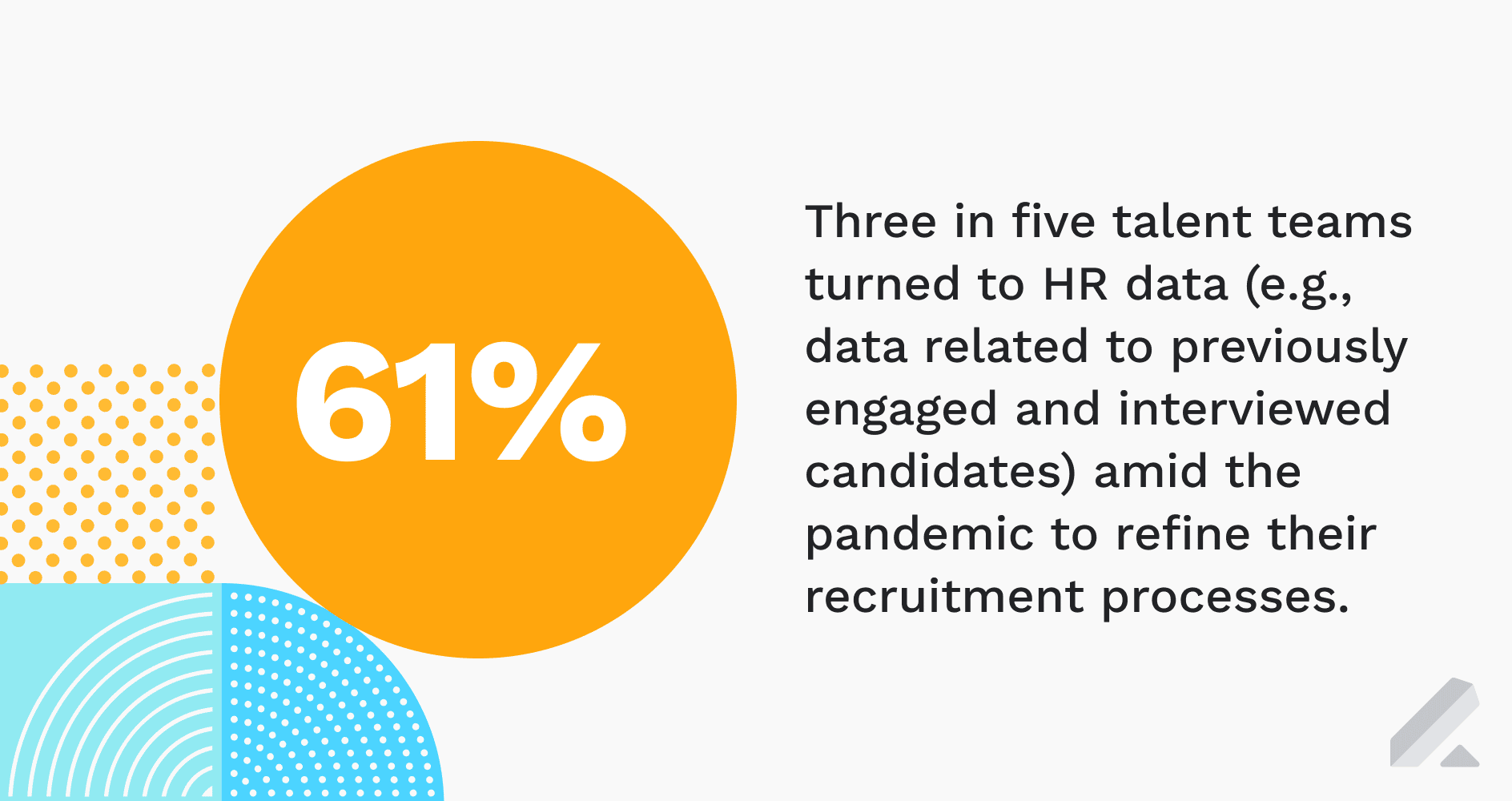Just as your talent acquisition team collects a sizable amount of data pertaining to recruiting performance and candidate experience, your human resources team amasses a wealth of HR data associated with your workforce on an ongoing basis.
The beauty of this data-collecting? Both teams can benefit from each other’s analytics:
- HR professionals at your organization can tap into recruitment data that provide insights into what prospective hires think about the business, which can inform employer-brand enhancements (e.g., modifications to the external communications guide to better position the company in public-facing messaging, like job descriptions).
- You and your colleagues in TA can extract useful intel from HR systems — notably, your human capital management (HCM) software. Doing so can help you determine what traits high-performing employees have — ones that can help you optimize your candidate personas and better understand what high-quality hires look like.
Predictive analytics is undoubtedly the future of workforce and talent planning.
So, it only makes sense the data that enables HR pros to get insights into things like the work environment and employee experience can help their counterparts in talent acquisition better identify, engage, interview, and extend offers to top talent for key positions.
The question becomes: How can you make the most of HR data to augment your outreach, engagement, and interviewing efforts and advance and hire only the strongest prospects?
What is HR data analytics? A breakdown of the important data source for talent professionals
People analytics. Workforce analytics. Talent management analytics. HR data is categorized in many ways. (Though there are nuances to these seemingly synonymous HR analytics terms.)
The definition of HR data analytics, however, essentially boils down to this:
- Actionable insights that not only help your HR department track employee productivity, measure the impact of employee engagement initiatives, and plan headcount, but also enable your talent acquisition team to be far more effective and efficient with its sourcing, nurturing, interviewing, and pipeline management efforts.
When these actionable insights ‘merge’ with the recruiting analytics you collect and use daily — ideally, in a centralized, single source of truth like a complete talent acquisition suite — you open up a lot of new opportunities to enhance the ways in which your TA org operates.
As HR expert and Excellence in People Analytics coauthor David Green noted in a recent McKinsey Talks Talent podcast episode, the incorporation of HR data in one’s recruiting strategy can be a boon for talent acquisition teams today.
- Specifically, David stated HR data provides talent leaders and recruiters with workforce-related insights that can aid their efforts to better connect with and convert highly qualified job seekers.
“You can look at analytics across the recruitment process,” David relayed on the podcast. “You can start to see where you might be suffering significant candidate drop-off. You can start to understand if you have a problem around offer to accept.”
And you can start to collaborate better with HR on your full life cycle recruiting to ensure you collectively and continually improve your hiring speed, quality, and efficiency.
5 important recruiting and hiring metrics that HR data access can help you improve over time
More to the point, you and your colleagues in HR can enhance these essential metrics.
1) Sourcing quality
Sourcing quality doesn’t just impact the roles you’re trying to fill and teams you’re trying to aid. It also has a downstream impact on your entire organization’s ability to find talent for you.
As our exhaustive guide on candidate sourcing strategies states:
- “If you devote time to sourcing quality candidates, you won’t just end up with a hire — you’ll also have candidates who are qualified to recruit for future roles.”
Turn to your HR data to determine how hires you helped get ‘over the finish line’ have performed over the first six months or so on the job. These performance insights can tell you which sources led to the strongest employees. In turn, you can double down on ‘high-yield’ sources and perhaps reduce (or eliminate) dependence on others.
2) Talent diversity
Your talent team can source and nurture a diverse array of candidates to ensure you build a highly diverse pipeline. But hiring managers make the final decisions on who to extend offers to, so your recruiting org has less control regarding which prospects are ultimately hired.
- That said, you can still work closely with hiring managers to rectify any diversity-hiring issues.
Notably, you can analyze your HR data and make necessary — and insights-driven — adjustments to your recruiting approach to employ more diverse prospects for their teams.
“Data can show … popular locations replete with talent aren’t always optimal locations that offer stronger representation of females and ethnic underrepresented talent,” Gartner noted.
3) Offer acceptance
If you’re like many talent teams, you ‘tag’ specific reasons why prospects turn down offers extended by your org and review data related to those reasons monthly or quarterly.
- But do you also turn to your HR data to understand why new hires sign offer letters?
In other words, do you and others on your talent team comb over the notes and context new employees provide your human resources department when onboarding?
Reviewing post-hiring surveys (i.e., ones sent to archived candidates and new hires) and any other info HR collects from recently employed staff members can give you and your recruiting team more granular insights into what helps entice prospects (e.g., desirable salary and perks, strong company culture) to ultimately join your business.
4) Hiring velocity
In an ideal world, when a new requisition opens, your talent team closes an open one (i.e., fills the position in question). This one-to-one ratio is rarely realized, though. Often, several new reqs will emerge with numerous open ones yet to be closed.
The silver lining? This is an issue nearly every TA org has to tackle. The ideal solution to speeding up your time to fill and, thereby, improving your hiring velocity? Examine HR data to pinpoint potential problem areas that prevent recruiters from ‘reaching’ top talent.
For instance, your company’s human resources data may show your talent acquisition team has an insufficient budget to execute its ideal recruitment marketing approach.
- A bump in spend allocated to TA could lead to more (and more targeted) advertising opportunities to connect with qualified candidates deemed optimal fits for open and upcoming roles.
That means more premier prospects can be screened and — if the rest of your recruitment funnel is a well-oiled machine (i.e., all hiring stakeholders collaborate closely, communicate often, and ‘move’ on top talent quickly), key roles can be filled more speedily.
5) Employee and candidate experience
Employee turnover data can show what led previous staff members to head to the door. Candidate Net Promoter Scores (CNPS), can tell you what prospects think of your business.
Combined, these insights can help you attract and retain high-quality workers. Moreover, they can empower you to gradually improve the candidate experience (CX) you provide talent you speak with for active roles as well as your employees’ experience.
For example, if your CNPS is lower than desired (you want an average of nine out of 10 or higher, as Starred’s Sophie Kraanen shared in her CX-focused Ascend session), based on surveys you send individuals you’ve engaged and interviewed, use the feedback shared in those surveys to adjust various aspects of your recruitment strategy.
- If several job candidates say your promotional messaging for active roles was a bit too aggressive, pare back your marketing/messaging frequency.
- If some prospects felt some questions asked during interviews seemed irrelevant or confusing, revisit your interviewing approach with hiring managers and HR.
- If the application process was deemed too laborious, consider investing in better TA tech that streamlines and speeds up applying for active job seekers.
The exact candidate feedback shared will vary from one business to the next. The point is these kinds of remarks and recommendations can help you build a smarter recruitment strategy.
Syncing HR data in your recruitment solution critical to long-term talent acquisition success
Connectivity between your talent acquisition tech and HR solutions of choice isn’t a nice-to-have today. Rather, it’s essential to your recruiting and hiring success, as it gives your TA leaders and specialists alike a holistic view of your performance, candidate, and employee data.
Consider Centro. The business connected our native talent acquisition suite with its HRIS. This led to a more complete, near-real-time view of sourcing, nurturing, interviewing, offer, and new-hire data that empowered its recruiters to work smarter.
As our case study states, “Centro immediately began seeing benefits in the unified workflow between Lever and Workday. Data began flowing seamlessly between the two systems, leading to new strategic insights around employee retention, referrals, and more.”
If you don’t have a direct integration between your main recruiting solution and HR systems, it’s likely a sign your TA tech stack needs an upgrade — especially if you rely on a legacy ATS.
Watch our webinar with SemperVirens and CloserIQ to learn how you can leverage your organization’s HR data to improve your headcount and talent planning in the years ahead.

